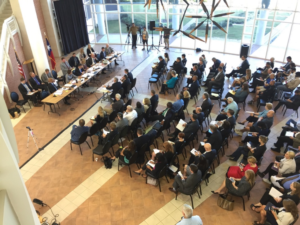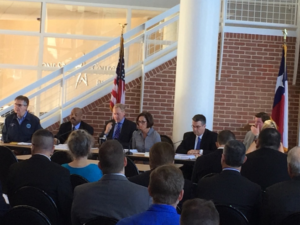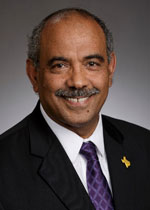How do we study and identify ways to improve the capacity of and further maintain the structure of the Addicks and Barker Reservoirs? What is the current state of data-sharing standards for rainfall and stream gauges? Should we develop a statewide real-time flood warning system coordinated through mobile devices? Can the existing local and regional forecasting infrastructure be integrated into a centralized inclement weather forecasting system?
These are some of the main questions Texas Senate Committee on Agriculture, Water and Rural Affairs addressed during its Public Hearing that was held in New Caney on Monday, October 16, 2017. Lieutenant Governor Dan Patrick also participated in this public hearing and stressed the severity of the flood on Texas and the US economies. Representatives of several state and federal agencies testified at this public hearing.
Senator Lois Kolkhorst of District 18 mentioned on one of her several interventions during this hearing that we can’t stop Hurricanes, but we can mitigate their impacts. District 18 includes Waller County and over a third of Texas coastal counties. Senators indicated that flood inundation maps were drawn back in the 1940s; thus, over 60% of the flooded homes during Harvey were outside the 100-year floodplains. New and accurate flood maps are needed. Members of the Senate committee raised other questions that affect the general public served, such as: What does 1000 cubic feet per second in the Brazos mean to houses in its flood plains? How high will water rise along a particular stream and what does it mean to people living near it? How fast can the general public receive rainfall and flooding information?
The Cooperative Agricultural Research Center’s (CARC) Associate of Research, Ali Fares, participated in the events; he took this opportunity to meet and discuss potential collaboration between CARC and several state and federal agencies. One of the discussions was with Byron Williams, Chief of Project Management Branch at the U.S. Army Corps of Engineers (USACE) Galveston District. Chief Williams indicated his interests in potential collaboration opportunities with the College of Agriculture and Human Sciences in the research and academic areas, including potential internships for students. He also mentioned that Col. Lars Zetterstrom, District Engineer and Commanding Officer of Galveston District has been very supportive of such initiatives, and he would interested in visiting PVAMU.
The PVAMU Water Team in CARC has experience in disaster management including pre-, during, and post- flooding prediction and mitigation using the U.S. Army Corps of Engineers’ and the National Weather Service’s decision support system, e.g. the Gridded Surface Sub Surface, (GSSHA) and HEC software packages, NWS-RDHM, SAC-SMA. Currently, the Water Team members are analyzing what happened in the Cypress Creek Watershed during Harvey using the USACE GSSHA software package. Our analysis includes simulating the potential impact of Harvey if we had one large reservoir or multiple smaller reservoirs across the watershed. Results of these analyses will be shared with all stake holders and the general public.

A Photo of the public hearing held in New Caney, Monday, October 16, 2017

Lieutenant Governor Dan Patrick delivering his remarks during the Public Hearing, Monday, October 16, 2017

Ali Fares Ph.D.
Associate Director for Research
(936) 261-5019
alfares@pvamu.edu
